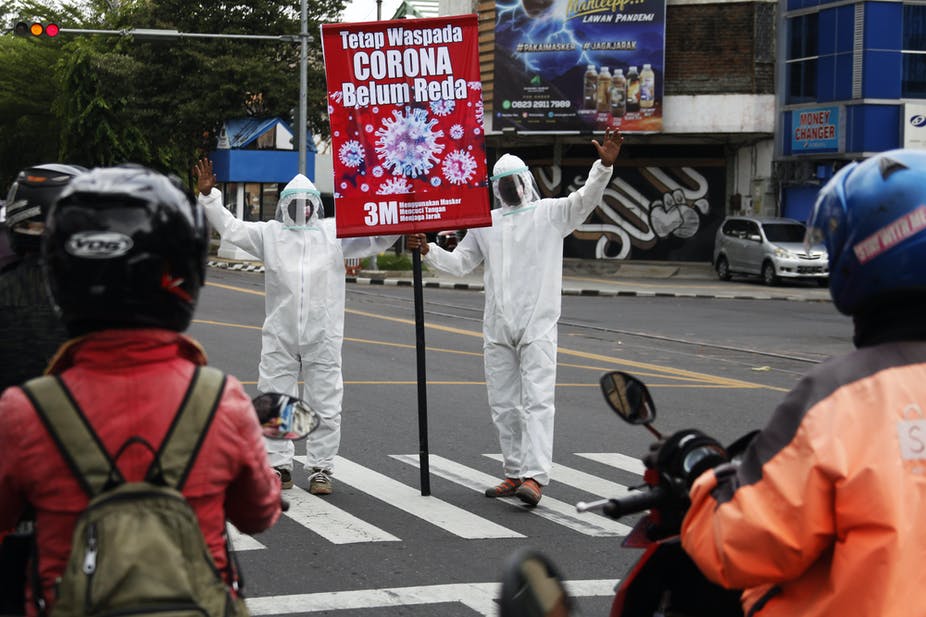The general occurrence of COVID-19 is a disruptive event that increases morbidity and mortality globally and causes severe economic, social, and political impacts. Since the World Health Organization (WHO) has declared the pandemic status of COVID-19 on March 11, 2020. Learning from the experience of the last influenza pandemic, one of the major mitigation interventions includes curtailing interactions between infected and uninfected populations through social distancing (SD) measures. SD measures aim to control the disease spread and reduce the attack rate through several approaches, such as school closures, workforce and community contact reductions.
Following the WHO’s recommendations, SD measures have been practiced in Indonesia. Since March 15, 2020, the central government has prompted the local governments to close all schools and implement work-from-home policies as efforts to reduce workforce and community contact. Nevertheless, the stakeholders hardly perform a comprehensive review of these policies as the impacts of SD measures remain unclear. Even though SD tends to lower the peak of incidence and have less upfront costs, it is considered to have higher indirect costs. This study aimed to estimate the costs and effects of SD measures for mitigating the COVID-19 pandemic in Indonesia.
Two mitigation scenarios of SD for 1 month and continuous SD were compared with the baseline (no intervention). A modified Susceptible-Exposed-Infected-Recovered (SEIR) compartmental model accounting for disease spread during the latent period was applied by considering a 1-year time horizon. The costs of healthcare, school closures, and productivity loss due to disease and intervention were considered to estimate the total pandemic cost among all scenarios.
The results confirmed that the overall expenses of the pandemic was $777 billion, $362 billion, and $78 billion in the baseline, SD for 1 month and continuous SD, respectively. In addition, the cost of healthcare, school closures and productivity loss due to disease and intervention were considered to estimate the overall pandemic cost in all scenarios. Both mitigation scenarios were thought to be cost-saving since these approaches were more successful while still being less expensive. Sensitivity analysis showed that basic reproduction number, infectious period, daily wage, incubation period, daily ICU hospitalization cost and case mortality rate were the most essential parameters influencing the savings and the number of averted deaths.
SD has been widely considered as alternative measures, particularly when vaccines and antiviral drugs remain under development. This study confirmed that SD measures through school closures, workforce, and community contact reductions potentially decrease the total number of outpatients, non-ICU and ICU hospitalizations, as well as deaths due to COVID-19 in Indonesia. In a 1-year time horizon, the continuous SD scenario tended to reduce the number of COVID-19 cases by >90%. The result is similar to previous studies that SD measures are effective in reducing new cases of COVID-19. The benefit of implementing SD measures in a pandemic situation is assumed to be favourable. In general, a long period of SD measures can be predicted to lead to the greatest reductions in terms of peak and cumulative attack rates
This is the first economic evaluation study for mitigating the COVID-19 pandemic in Indonesia, therefore, it has several major innovative aspects, the setting used was specifically focused to be in the country, this study was conducted from the societal perspective, and two mitigation scenarios were developed within a hypothetical model of disease spread on the duration of SD measures. This is crucial since the government has the policy to review the decision periodically, and cost-effectiveness is an important criterion for prioritizing mitigation strategies in a pandemic situation. The lack of reliable local data on epidemiological parameters was discovered to be the study’s main limitation. To deal with this, data were extrapolated from several published studies in China, and the issue in question was examined in the sensitivity analysis.
Author: Inge Dhamanti, PhD Complete article : https://www.sciencedirect.com/science/article/pii/S1477893921002866





